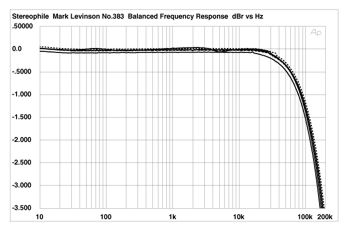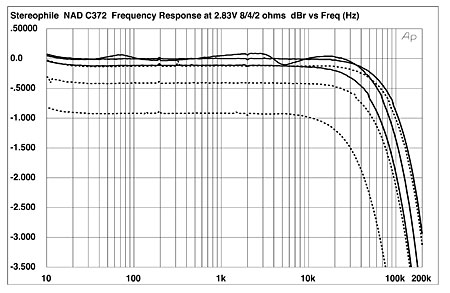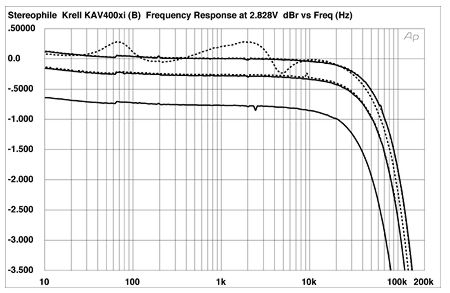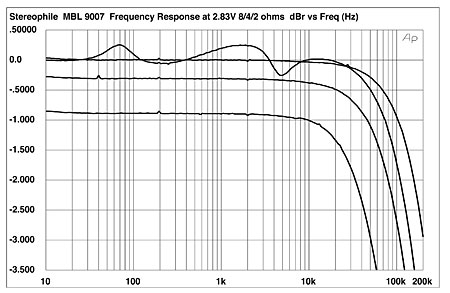The extra loop gain allowed by a higher switching frequency is employed to correct the higher dead time error also due to the higher switching frequency. There is no advantage in that respect. THD performance is same as 350Khz UcD. Snubber losses and switching losses increase three fold, though.
The clmaims on Fumac's site derived from the triangle-wave figures are wrong.
I don't find anything interesting on those pictures showing square waves on an CRO.
Carrier residual is something inherent to switching amplifiers and there is no need to suppress it.
There is no point in amplifying components above 20Khz, anything above 20Khz entering an amplifier is usually ambient EMI hash and should be filtered.
The clmaims on Fumac's site derived from the triangle-wave figures are wrong.
I don't find anything interesting on those pictures showing square waves on an CRO.
Carrier residual is something inherent to switching amplifiers and there is no need to suppress it.
There is no point in amplifying components above 20Khz, anything above 20Khz entering an amplifier is usually ambient EMI hash and should be filtered.
Eva, you are being too kind.
Fumac's relentless sales pitches consistently demonstrate a failure to grasp the most basic concepts of modulation theory.
When you start by ripping off "perfection" though, it is easy to "improve" it.
"sorry, dont ask about this,
i'm making living on it, i have read about >3000 types mosfet datasheet, and test >100 types mosfet, then select <10 types for our project."
That's PATHETIC. You have ripped off others and yet aren't even willing to discuss your choice of mosfet? Like we can't find out .... if we really cared to?
Clearly you don't have much to go on.
Fumac's relentless sales pitches consistently demonstrate a failure to grasp the most basic concepts of modulation theory.
When you start by ripping off "perfection" though, it is easy to "improve" it.
"sorry, dont ask about this,
i'm making living on it, i have read about >3000 types mosfet datasheet, and test >100 types mosfet, then select <10 types for our project."
That's PATHETIC. You have ripped off others and yet aren't even willing to discuss your choice of mosfet? Like we can't find out .... if we really cared to?
Clearly you don't have much to go on.
Eva said:The extra loop gain allowed by a higher switching frequency is employed to correct the higher dead time error also due to the higher switching frequency. There is no advantage in that respect. THD performance is same as 350Khz UcD. Snubber losses and switching losses increase three fold, though.
so this means its better to stay in the 350Khz UcD "zone", right??
RX5
I would say that if you are able to design an output stage which has much smaller parasitic components (series inductance and parallell capacitance) you can start switching with much higher DV/DT without causing higher ringings and radiated noise. If the propagation delay and DV/DT is improved by a factor of two you can move the filter resonance by the same amount, double the fsw and get a self oscillating amplifier with 6dB higher loop gain at 20kHz hence less distortion. It would also have less phase shift (which is useless but anyway).
A problem that can occur is that if the output filter has a too low filter cap the amp stability gets affected by driving a capacitive load.
I would say that if you are able to design an output stage which has much smaller parasitic components (series inductance and parallell capacitance) you can start switching with much higher DV/DT without causing higher ringings and radiated noise. If the propagation delay and DV/DT is improved by a factor of two you can move the filter resonance by the same amount, double the fsw and get a self oscillating amplifier with 6dB higher loop gain at 20kHz hence less distortion. It would also have less phase shift (which is useless but anyway).
A problem that can occur is that if the output filter has a too low filter cap the amp stability gets affected by driving a capacitive load.
Bender.ru said:Fumac, EMI & switching residual are two big differences
this is just your thinking.
switching residual is one part of emi.
there are not same thing, but they have relationship.
if class-d designer don't care about switching residual,
then you can design a class-d without output filter, or you can design the output filter at the speaker box.
but , why no one do this ?
a part of THD come from the output filter.
diffrent thinking will give you diffrent answer.
Eva said:The extra loop gain allowed by a higher switching frequency is employed to correct the higher dead time error also due to the higher switching frequency. There is no advantage in that respect. THD performance is same as 350Khz UcD. Snubber losses and switching losses increase three fold, though.
The clmaims on Fumac's site derived from the triangle-wave figures are wrong.
I don't find anything interesting on those pictures showing square waves on an CRO.
Carrier residual is something inherent to switching amplifiers and there is no need to suppress it.
There is no point in amplifying components above 20Khz, anything above 20Khz entering an amplifier is usually ambient EMI hash and should be filtered.
eva, dont just talking the msg from book, make a very low thd class-d amp just running at 100k,
good job is better than good words.
as your thinking , you can make a class-d amp, with very low thd and full range (20~20khz)and just running at 100k , also including low EMI,
so , please show us your low thd class-d amp.
as you say, that's a very easy job to you,
don't stop at reading a book, do it please
rg
fumac
Iyremenko said:Eva, you are being too kind.
Fumac's relentless sales pitches consistently demonstrate a failure to grasp the most basic concepts of modulation theory.
When you start by ripping off "perfection" though, it is easy to "improve" it.
"sorry, dont ask about this,
i'm making living on it, i have read about >3000 types mosfet datasheet, and test >100 types mosfet, then select <10 types for our project."
That's PATHETIC. You have ripped off others and yet aren't even willing to discuss your choice of mosfet? Like we can't find out .... if we really cared to?
Clearly you don't have much to go on.
as you can find out the mosfet, ok don't ask me please.
our mosfet is drop from God,
but i can told you a truth (i have told others at this forum):
Most of the mosfets can run at 1MHz, you can take a look at the datasheet of mosfet, the manufactury tested the mosfet at 1mhz"
rg
fumac
Eva said:The extra loop gain allowed by a higher switching frequency is employed to correct the higher dead time error also due to the higher switching frequency. There is no advantage in that respect. THD performance is same as 350Khz UcD. Snubber losses and switching losses increase three fold, though.
Pabo, phase could be useless if all you make is subwoofer class d. Though in the context presented by fumac, yeah.
Ivan, you just invented fumac's next product line. Though, that would not be BD
Fumac I dare say, you are unconvincing with your dropped from god references, be them jokes or not, it is a very weak, and incorrect standpoint. One wonders if that is your best.
I have zero need to know your mosfet, but I think you should be able to discuss it openely. If you find that secretive, proprietary information, I think you'll sink real fast.
What has god given you for EMI performance ?

Ivan, you just invented fumac's next product line. Though, that would not be BD
Fumac I dare say, you are unconvincing with your dropped from god references, be them jokes or not, it is a very weak, and incorrect standpoint. One wonders if that is your best.
I have zero need to know your mosfet, but I think you should be able to discuss it openely. If you find that secretive, proprietary information, I think you'll sink real fast.
What has god given you for EMI performance ?

For a given circuit, the amount of EMI energy radiated is proportional to the switching frequency (to the number of switching events per second), so a given circuit operating at 1Mhz will produce 3 times more EMI than at 330Khz.
Instead of showing us square waves, you could as well show us the carrier residual at the output of the amplifier with no input signal and a dummy load connected to one of the supply rails to force some current to flow and drive the output stage into non-resonant hard switching.
The amount of hash in the resulting waveform tells a lot about the quality of any class D amplifier...
Phase is not relevant, group delay is. A reasonably flat group delay is always ok.
Instead of showing us square waves, you could as well show us the carrier residual at the output of the amplifier with no input signal and a dummy load connected to one of the supply rails to force some current to flow and drive the output stage into non-resonant hard switching.
The amount of hash in the resulting waveform tells a lot about the quality of any class D amplifier...
Phase is not relevant, group delay is. A reasonably flat group delay is always ok.
Iyremenko said:Pabo, phase could be useless if all you make is subwoofer class d. Though in the context presented by fumac, yeah.
Ivan, you just invented fumac's next product line. Though, that would not be BD
Fumac I dare say, you are unconvincing with your dropped from god references, be them jokes or not, it is a very weak, and incorrect standpoint. One wonders if that is your best.
I have zero need to know your mosfet, but I think you should be able to discuss it openely. If you find that secretive, proprietary information, I think you'll sink real fast.
What has god given you for EMI performance ?

i will post emi test pictures here, please wait
we need to pay a proffession company to test it .
at my lab now, i can told you about using the MCD
MCD can work very well with TV set and FM radio.
even mcd is not installed in a cover box.
i have no instereting at high power damp(>1000w).
because i have test many class-h amp(1000w ~2000w to 8ohm made by my friends)
i found , class-d is not good at high loading (8ohm) and class-h is very good at high load and huge power output.
(full audio range 20hz~100khz)
we do resaerch at class-d , so we know which using is good for class-d,
class-d good at : bass boost (even high power to 10kw is ok), full range, to about 1kw 4ohm is ok, also can drive 1ohm to 2ohm
class-h, very good at high power, high load, 1000w 8ohm~ 3kw 8ohm, when you test a good class-h, you will find: 400w rms to 8ohm thd<0.01% at 1k ,
then you will know , which is better for PA system.
so , we will stop class-d rearch when our 1000w 4ohm version (full audio band )is finished. we have no any instereting at bass-boost class-d amp.
a real class-d designer must to know about which is the best of class-d and which is worst of class-d.
forget about the 1kw 8ohm, full range(at least 20~100k),will not better than class-H now,
class-d need a super fast mosfet. then will be more good at high power and full range audio
about our new project:
after that, we will goto SMPS, infact now ,we are testing the first test version of smps for hifi audio ,
250w rms and 600w peak, we have tested it , the noise floor is about 50mV, this is a bit high for hifi audio, so need to do with it
we have a diffrent thinking at smps, we will have the fastest speed loop of reg, this is one of the way to make good sound, and dynamic.
this version is just running at 350k, but we want a mhz level smps.
you can take a look at : vicor, they are making very good high power DC-DC working at 1mhz.
rg
fumac
Eva said:There is no point in amplifying components above 20Khz, anything above 20Khz entering an amplifier is usually ambient EMI hash and should be filtered.
hi eva, i have told you about tannoy
ok , let me post the link again here:
http://www.tannoy-speakers.com/s.php?product=140&title=ST200&s=27
ST200
Introduction
Always an innovator where quality sound reproduction is concerned, Tannoy has continued this tradition by being at the forefront of the development of WideBand™ technology. All Prestige models except Autograph Mini are compatible with
Tannoy’s SuperTweeter™ designs, providing the opportunity to extend high-frequency response to above 50 kHz
, thereby providing all of the bandwidth required for today’s wide bandwidth digital recording formats.
you can ask tannoy , for what , why need a speaker from 18k~50k, they have three types about this
An externally hosted image should be here but it was not working when we last tested it.
more info about top hifi amp
Mark Levinson No.383 integrated amplifier
150k-3db,
link
http://stereophile.com/integratedamps/245/index6.html

Mark Levinson No.383 integrated amplifier
150k-3db,
link
http://stereophile.com/integratedamps/245/index6.html

NAD C 372 integrated amplifier:
http://stereophile.com/integratedamps/1006nad/index5.html
150k~200k -3db

http://stereophile.com/integratedamps/1006nad/index5.html
150k~200k -3db

Krell KAV-400xi integrated amplifier:
http://stereophile.com/integratedamps/205krell/index4.html
100k-3db

http://stereophile.com/integratedamps/205krell/index4.html
100k-3db

mbl Reference 9007 power amplifier:
http://stereophile.com/solidpoweramps/906mbl/index4.html
200khz-3db !!

http://stereophile.com/solidpoweramps/906mbl/index4.html
200khz-3db !!

Hey Fumac...Have you ever heard about group delay and impulse response of an amplifier....No need to go to 100Khz for this with switching amplifier...This is mostly related to output filter. In other hand, analogue amplifier need a wide frequency response to have good group delay and impulse response...Think about this! Eva is totaly right about too hight switching frequency...
Fredos
Fredos
- Status
- This old topic is closed. If you want to reopen this topic, contact a moderator using the "Report Post" button.
- Home
- Amplifiers
- Class D
- MHz amplifier